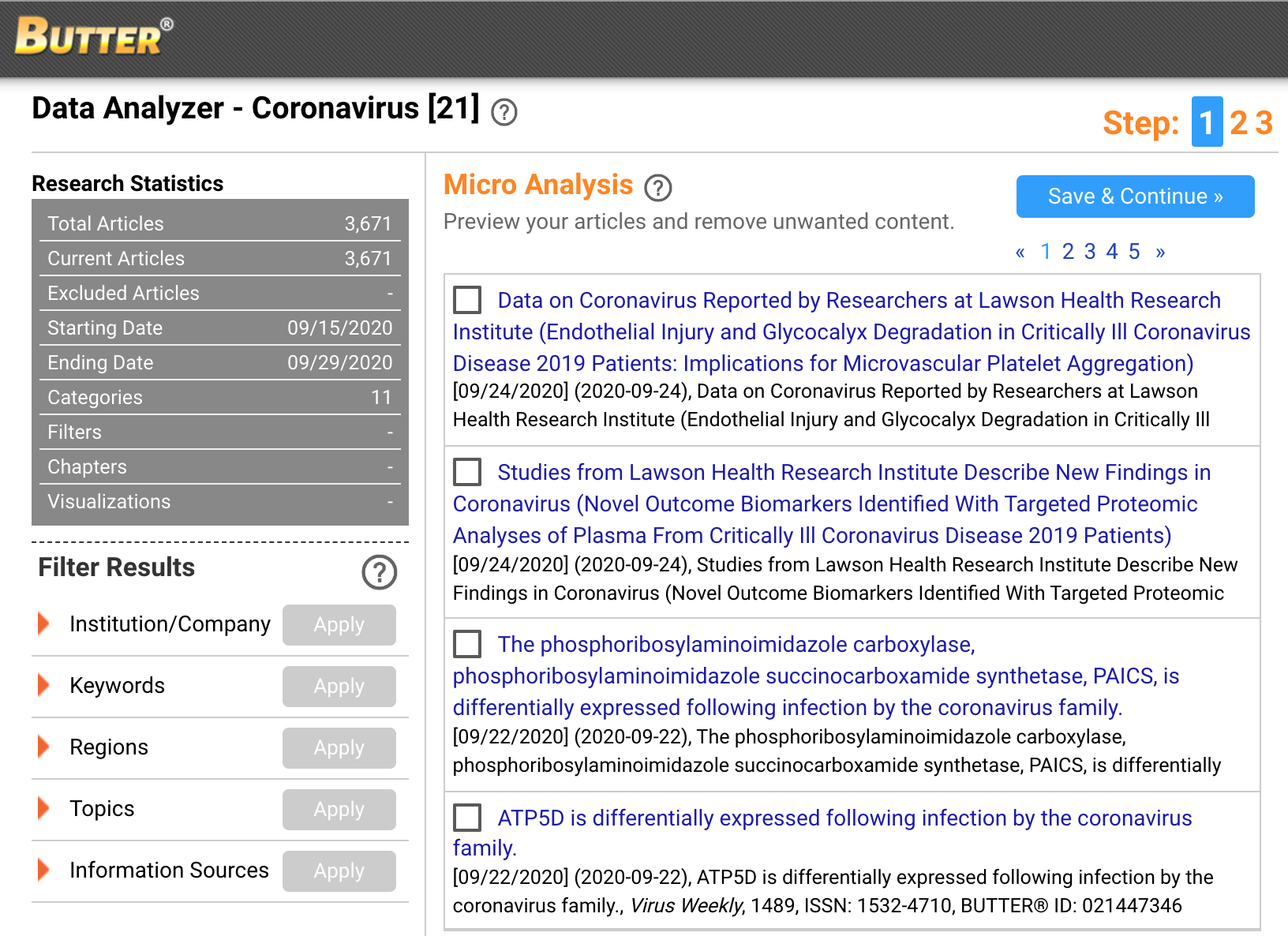What Is Proactive Research?
Proactive research is a research and discovery tool that...
-
Utilizes state of the art technology to reduce the burden of research;
-
Locates what you would usually spend hours of your own valuable time researching, and sends it to your inbox every day;
-
Enables you to learn about essential discoveries and developments in your field that you previously had no way of finding;
-
Automatically locates high-quality, accurate, and legitimate content.
Proactive research is set to take over as the future of sound, legitimate, and successful research in not just the world of science, but in business, medicine, finance, law, energy, and any field that demands rigorous and accurate content at the rate that the world's new discoveries appear.
We're living in an age where the sheer amount of content is exploding—to be specific, over two million new articles are published online every day. And that’s not fake news: a lot of it is research-based, rigorous content.
Nowadays barriers of entry to business have dropped. The days of needing to be able to talk face-to-face with your potential clients and customers are long gone. All you really need is a phone and internet access to start affecting the market, so breakthroughs and market shifts happen at an unprecedented pace.
We’re also living in era where patents define wealth. There’s a reason why IBM won more 6000 patents in 2017 alone. A lot of technological breakthroughs can first be seen in the form of patents rather than research studies, because that’s how change-makers effectively monetize new technology.
But what does it all mean?
It means that more often than not traditional research doesn't get the job done for scientists, researchers, business professionals, and content creators. As a result, the world is turning towards proactive research--Research 2.0.

Traditional Research Vs. Proactive Research
Traditional research is the way that research has been conducted for hundreds of years up until today, but let's get a better grasp of how it really works. Let's try setting up a simple distinction: traditional research can be defined as process-driven and reactive, whereas proactive research can be defined as results-driven and dynamic.
Process Driven
Process-driven means that you have to go through a whole course of steps to conduct research. You have to reference 10, 20, 100 books, websites, scientific and professional journals, and news publications. You have to conduct 10, 20, 100 Google searches, or searches on Library Management Systems or academic search engines. You have to read hours worth of articles, parsing the articles for reliability, quality, and relevance to your own needs. And at the end of the day, you know there’s a chance that you simply didn’t manage to find the article or study most relevant to you.
Reactive
Meanwhile, reactive means that traditional research is typically conducted in response to the company's needs, or in response to ongoing business or scientific developments outside the organization. Specific business and research goals demand gathering a volume of research about a specific topic, like corporate analytics software or drugs containing opioids. Or you realize, by chance or hearsay, that there’s something important going on—perhaps a client or colleague mentions a new medical technology or patent in your field. In either case, you conduct research as a reaction to some outside force.
So if traditional research, research as we know it—conducting online and library searches, reading websites and journal articles—can be defined as process-driven and reactive, let's take a look at what proactive research is like.
Results Driven
Results-driven means that the methodical steps of conducting research are already taken care of, leaving you with the results. Artificial intelligence technology can complete tiresome tasks typically reserved for humans, including: searching the web for content; narrowing down the content based on keywords, time-frame, location, and type of source; determining if content is inaccurate, poor-quality, or inadequately sourced/cited. Not only can AI complete these tasks, but it can do them faster than humans can. It takes the average person 2 minutes to read a page-long article—so even if you can figure out if an article is inadequate by reading the first couple of paragraphs, that could be a whole minute wasted on an article that’s just plain bad. Results-driven research uses AI to complete the exhausting, methodical steps of research.
Dynamic
Dynamic means that you’re not just responding to immediate concerns and needs. Research becomes generative. So if you complete a search once, you are able to receive alerts about any incoming articles, patents, trademarks, company announcements, and clinical trials that relate to your chosen area of inquiry. For example, at NewsRx we like to keep alerts for research and patents related to Artificial Intelligence. So whenever a quality research study is published about AI technology, we get an alert.
A simple but important fact of research is that you can’t look up what you don’t know you ought to be, well, looking up. That might be patents or trademarks in your field that reveal an important competitor, collaborator, or methodology. It could be studies and corporate developments occurring outside of the U.S. By conducting ongoing research in real-time among the whole universe of quality-checked content, proactive research creates new, unsuspected, and inspiring opportunities, without taking up any of your time.
That's the difference?
Traditional research, process-driven. Proactive research, results-driven. Traditional research, reactive. Proactive research, dynamic. Traditional research consists of exhaustive labor in a narrow field. Proactive research is conducted by artificial intelligence across the entire universe of content.
That just about sums it up.

The Good and the Bad of Research Methods
Traditional Research
|
PROS |
CONS |
|
Immersive—see the massive world of content with your own eyes |
Time intensive—can take an exhausting amount of time and effort |
|
On your own initiative—no notifications, no alerts, no emails—you control the time and place |
Time sensitive—by conducting research monthly, weekly, or even daily you can miss time-sensitive news |
|
Familiar—keep doing what's always been done! There are no consequences to taking a "wait and see" approach... yet |
Boring—it’s easy to see why scanning hundreds of articles just to see if they're even relevant might feel like a waste of time |
Proactive Research
|
PROS |
CONS |
|
Fast—AI does the bulk of the work for a researcher. No more need for all those endless hours of reading just to test out an article's relevancy |
Different—shifting to proactive research requires a willingness to use a more intensive search engine to set up alerts, and then to step back and wait |
|
Notifications—an alerts system tells a user when a relevant study or article is published according to their specifications, so you only ever need to conduct a search |
Hands-off—the hands-off nature of proactive research means that you can’t get data when you want it, especially if at the time there aren't developments in your field |
|
Quality-checked—results are free of erroneous information, insufficient data, and low quality articles |
Not free—good research engines, though they certainly won't break the bank, require some investment |

Uses for Proactive Research
Proactive research can be used in all the ways that traditional research can be used. However, there are some applications that are especially exciting, as they leverage all the advantages inherent in Research 2.0.
General Scientific Research
Proactive research can set up notifications and alerts for both general and highly specialized scientific topics. One the one hand, you could set up to be notified whenever there is news about polymer technology. But let’s say you wanted to know whenever there were new patents on one specific type of polymer coming out of the United States and Canada—that works too. Proactive research enables scientists stay on top of the latest developments in the field without having to exhaustively go through scientific journals and publications.
Business Competitiveness and Development
Proactive research is an efficient way to keep up with competitors. Since proactive research tracks all kinds of documents beyond news, including patents, trademarks, and company announcements, you can set up notifications to be alerted about developments in your field. Nowadays, most individuals and corporations use patents to register new technology and inventions before publishing research or official announcements, so a lot of the time keeping track of patents is the fastest and most accurate way to learn about ongoing advancements.
Pharmaceutical Early Drug Discovery and Development
Proactive research can really come in handy for companies and individuals in the early stages of pharmaceutical drug development. Proactive research allows for easy discovery of research relevant to identifying molecular entities and actives, as well as research that supports proof of therapeutic effects and druggability. Due to the long-term, exhaustive nature of drug development, using AI to conduct research automatically boosts the efficiency of early discovery and drug development.
Proactive Research & Discovery Tools
Proactive research is a new field, a new concept, a new entity—but it’s moving fast. While there are a lot of online tools to conduct traditional research, proactive research tools are few and far between. Research engines like EBSCO, JSTOR, RefSeek, or PubMed may come in handy for academic and professional web search queries, and other tools like Wolfram|Alpha and MIT’s Start use AI to answer math and science questions. However, believe it or not, there are currently only two "real", and very different, proactive research tools out there.
Google Alerts
Google Alerts is a proactive research tool in its most basic form. It works exactly the way a proactive research engine should: it sends you real-time alerts on topics that you’re interested in. You can select from a range of categories, including companies (Amazon, Tesla), finance (different stocks, the USD), and tech (the blockchain, D programing language). Google will then send you daily updates into your inbox with results on your selected topic, pulled from Google News.
So Google Alerts serves as a basic proactive research tool by sending you articles on your areas of interest—proactively! Still, it pulls from the imperfect and easily accessible world of news available to Google, which leaves out important research areas like peer-reviewed essays and patent notices. So by no means does Google Alerts dive deep into your areas of expertise like you do when you do your own research—it’s just a simple proactive alerts tool.
Butter
Butter, an online tool developed by NewsRx, is right now the most advanced proactive research tool available. Butter draws from a world of nearly 16 million articles—but that's not just your world of every day news. Those 16 million sources are quality-checked scientific research articles, patents, trademarks, company announcements, and clinical trial updates, and thousands and thousands of new reports get added to the database every day.
Setting up Butter’s proactive research is a little more complex than making a Google News alert, but for good reason—you can dive much deeper. Beyond a single search keyword, you can target topics, institutions, and regions of origin—all at the same time. That narrows down your results a ton.
One more benefit to BUTTER is that the tool’s computational journalism provides short, handy reports about the original article. Most scientific and corporate research articles are dozens of dense pages long, so Butter provides condensed research news briefs. This feature allows you to quickly scan information about comprehensive topics.

The Need for Proactive Research
Whether you’re a scientific researcher for a university, business development professional, or business owner or manager just trying to stay up-to-date in your field, research is going to be a huge component of your success. Many research professionals take one day a week simply to keep up with new developments in journals and publications relevant to their fields and projects.
The development of proactive research, while certainly an improvement over traditional research, shouldn't be seen as a simple advancement meant to make things easier. While to many, utilizing proactive research will “simply” make things easier, proactive research should be viewed in a broader context of underlying change in the world around us.
The two main developments that are really making proactive research come into its own are the decline of the Information Age and the rise of AI.
The Decline of the Information Age
The Information Age is no longer exciting to us, but exhausting. There’s too much data. Too many articles, too many notifications. Is there a single person in the entire world who is happy with the number of emails they get in their inbox every day?
There are a lot of arguments you could make about the problems with the Information Age. Some people say that it's repressed human creativity, by making us overly reliant on collecting and processing massive amounts of data that we cannot realistically understand. A natural backlash to the Information Age can come in a variety of forms, and a turn towards artificial intelligence—and a reluctance to continue using traditional research—is just one of those.
The Rise of AI
Artificial intelligence is coming. In the last two years, AI has rapidly integrated into a wide variety of fields—tech, finance, real estate, and journalism, just to name a few. With the growing popularity of products like Amazon’s Alexa, AI has also begun to enter our home lives. The basic definition of artificial intelligence—a computer that can perform human tasks—reveals the simple fact that humans save time and money by relegating certain tasks to applied AI, or artificial intelligence applied to solve human problems. The world of research is no different.
Proactive research is necessary in the short term because it solves the massive problem of information-overload in the world of business and science. It allows professionals to step back from the noise and focus on their jobs. And in the long-term, proactive research will become the necessary standard to keep up with the rapid pace of scientific and technological advancement—a world of knowledge, only furthered by the power of artificial intelligence.

